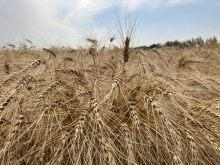Glacier FarmMedia | MarketsFarm — Soybean futures in Chicago could trade in a sideways range over the next few weeks, while the grains may trend lower, as the markets shift their attention to weather and new crop production prospects, said an analyst.
Jack Scoville of Price Futures Group in Chicago predicted that soybean prices will be sideways over the next couple of weeks, while corn and wheat will become oversold.
“(July corn) could trade back to the US$4.70 (per bushel) area and July Chicago wheat could be at the US$5.50 area,” Scoville said.
Read Also

U.S. grains: Corn, wheat ease after gains driven by Black Sea jitters
Chicago | Reuters – U.S. corn futures fell on Wednesday and wheat futures also dipped as fears eased about a…
During the week ended May 14, pressure was placed on grain futures due to the rapid pace of plantings and supportive growing conditions. The United States Department of Agriculture reported as of May 11 that the corn crop was 62 per cent planted, soybeans were 48 per cent seeded and spring wheat was at 66 per cent. They were six, 11 and seven points above their five-year averages, respectively. Winter wheat was 53 per cent headed, eight points above the average pace.
“We’ve got all sorts of expectations of big yields and not without reason,” Scoville added. “When crops get planted as early as they have, a lot of times we get very high yields.”
The trade is also monitoring long-term weather conditions, especially the prospects of drought this summer in the western half of the U.S.
“I think it’s the biggest thing people are worried about, above and beyond what’s going on in Washington with the tariff wars,” he said.
The USDA provided its first look at projections for the 2025-26 crop year in its monthly supply/demand estimates released on May 12.
Ending stocks for corn and soybeans were tighter than what the trade expected at 1.8 billion bushels and 295 million, respectively. On the other hand, wheat carryout was greater than trade expectations at 923 million bushels. Deferred contracts on the Chicago Board of Trade reacted accordingly, with corn and soybeans making gains and wheat varieties losing ground.
Scoville said the USDA’s use of production trendlines and previous acreage estimates did not make for too many surprises following the report’s release.
“I think the fact USDA was able to find so much demand was the big surprise because even with increases in production, ending stocks were reduced (for corn),” Scoville said. “On the other hand, wheat’s expectations really weren’t all that good.”















